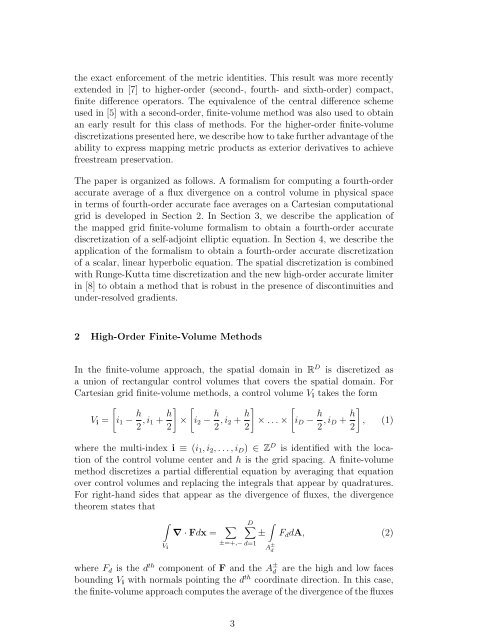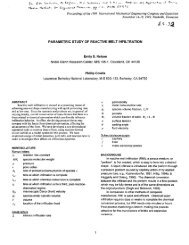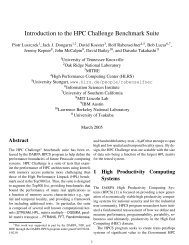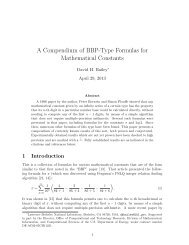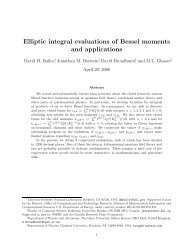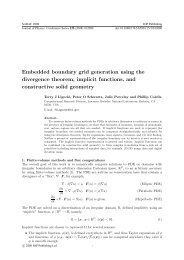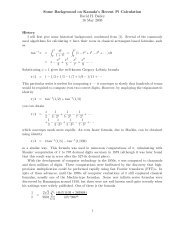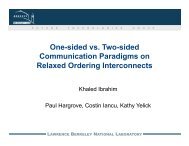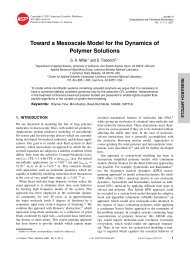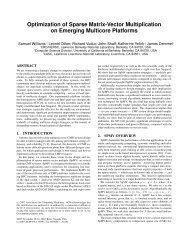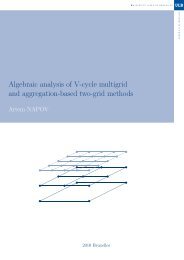High-Order, Finite-Volume Methods in Mapped Coordinates
High-Order, Finite-Volume Methods in Mapped Coordinates
High-Order, Finite-Volume Methods in Mapped Coordinates
Create successful ePaper yourself
Turn your PDF publications into a flip-book with our unique Google optimized e-Paper software.
the exact enforcement of the metric identities. This result was more recentlyextended <strong>in</strong> [7] to higher-order (second-, fourth- and sixth-order) compact,f<strong>in</strong>ite difference operators. The equivalence of the central difference schemeused <strong>in</strong> [5] with a second-order, f<strong>in</strong>ite-volume method was also used to obta<strong>in</strong>an early result for this class of methods. For the higher-order f<strong>in</strong>ite-volumediscretizations presented here, we describe how to take further advantage of theability to express mapp<strong>in</strong>g metric products as exterior derivatives to achievefreestream preservation.The paper is organized as follows. A formalism for comput<strong>in</strong>g a fourth-orderaccurate average of a flux divergence on a control volume <strong>in</strong> physical space<strong>in</strong> terms of fourth-order accurate face averages on a Cartesian computationalgrid is developed <strong>in</strong> Section 2. In Section 3, we describe the application ofthe mapped grid f<strong>in</strong>ite-volume formalism to obta<strong>in</strong> a fourth-order accuratediscretization of a self-adjo<strong>in</strong>t elliptic equation. In Section 4, we describe theapplication of the formalism to obta<strong>in</strong> a fourth-order accurate discretizationof a scalar, l<strong>in</strong>ear hyperbolic equation. The spatial discretization is comb<strong>in</strong>edwith Runge-Kutta time discretization and the new high-order accurate limiter<strong>in</strong> [8] to obta<strong>in</strong> a method that is robust <strong>in</strong> the presence of discont<strong>in</strong>uities andunder-resolved gradients.2 <strong>High</strong>-<strong>Order</strong> <strong>F<strong>in</strong>ite</strong>-<strong>Volume</strong> <strong>Methods</strong>In the f<strong>in</strong>ite-volume approach, the spatial doma<strong>in</strong> <strong>in</strong> R D is discretized asa union of rectangular control volumes that covers the spatial doma<strong>in</strong>. ForCartesian grid f<strong>in</strong>ite-volume methods, a control volume V i takes the formV i =[i 1 − h 2 , i 1 + h 2]×[i 2 − h 2 , i 2 + h 2]× . . . ×[i D − h 2 , i D + h 2], (1)where the multi-<strong>in</strong>dex i ≡ (i 1 , i 2 , . . . , i D ) ∈ Z D is identified with the locationof the control volume center and h is the grid spac<strong>in</strong>g. A f<strong>in</strong>ite-volumemethod discretizes a partial differential equation by averag<strong>in</strong>g that equationover control volumes and replac<strong>in</strong>g the <strong>in</strong>tegrals that appear by quadratures.For right-hand sides that appear as the divergence of fluxes, the divergencetheorem states that∫∇ · Fdx = ∑ D∑∫±V±=+,− d=1iA ± dF d dA, (2)where F d is the d th component of F and the A ± d are the high and low facesbound<strong>in</strong>g V i with normals po<strong>in</strong>t<strong>in</strong>g the d th coord<strong>in</strong>ate direction. In this case,the f<strong>in</strong>ite-volume approach computes the average of the divergence of the fluxes3


